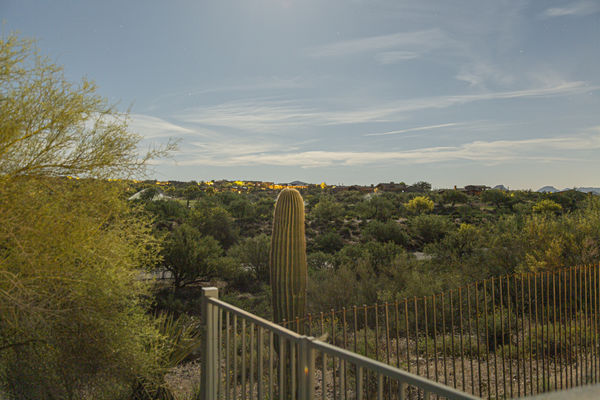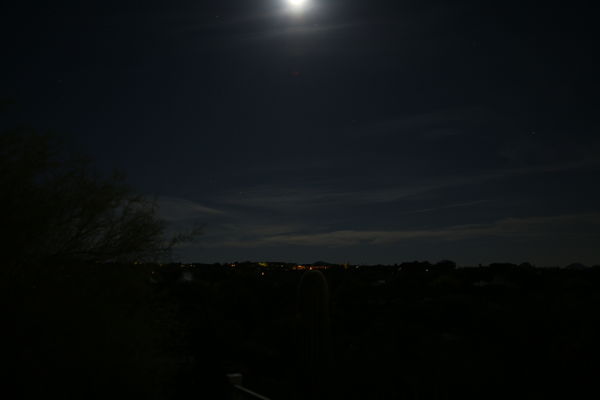Using in camera multiple exposures for illumination stacking
May 7, 2020 13:57:11 #
jayluber
Loc: Phoenix, AZ
My buddy Eric Gail introduced me to this technique of using the camera's internal multiple exposure capabilities to capture landscapes in low light where artificial illumination is not practical or desired. The result is a stacking of the light from consecutive images - but the result is almost noiseless - depending on the ISO used. My buddy has a program on his card that lets him use the multi exposure capability but he can also change the ISO of each capture. He then uses an ISO of 100 for the last take and that eliminates all noise. My Canon will not let me change ISO on each of the multi photos.
Here is an example photo I shot last night showing a friend how to do it. It is not a great (or even good) photo - but it is a good example of what can be done.
It was after 10:00 at night, almost full moon and I was shooting across a desert landscape with some homes in the far background with lights on. It was black from my location to the homes in the back. I coul dnot see the clouds with my naked eye. Canon 6D, Canon 24-105 f4 L. It is single photo direct from the camera derived from 6 photos at 2 sec, f4, ISO 400.
The photo is virtually noiseless and the foreground is nicely illuminated with great color transmission. You can even see stars in the sky. This is a great way to photograph at night and for milky way by doing the multi exp on the foreground and a shot or series of shots for the sky.
Thought I'd share with you all.
Let me know how it works out for you if any of you give it a shot.
Here is an example photo I shot last night showing a friend how to do it. It is not a great (or even good) photo - but it is a good example of what can be done.
It was after 10:00 at night, almost full moon and I was shooting across a desert landscape with some homes in the far background with lights on. It was black from my location to the homes in the back. I coul dnot see the clouds with my naked eye. Canon 6D, Canon 24-105 f4 L. It is single photo direct from the camera derived from 6 photos at 2 sec, f4, ISO 400.
The photo is virtually noiseless and the foreground is nicely illuminated with great color transmission. You can even see stars in the sky. This is a great way to photograph at night and for milky way by doing the multi exp on the foreground and a shot or series of shots for the sky.
Thought I'd share with you all.
Let me know how it works out for you if any of you give it a shot.
May 7, 2020 14:08:28 #
I don't know. Doesn't show me much. Perhaps next time you could show the same shot with and without.
May 7, 2020 14:12:54 #
jayluber
Loc: Phoenix, AZ
just imagine a totally black photo. take one at night at f4, 2 seconds ISO 400.
Guess you don;t do much night photography.
Guess you don;t do much night photography.
May 7, 2020 14:35:48 #
jayluber wrote:
My buddy Eric Gail introduced me to this technique... (show quote)
How is this different from exposure bracketing?
May 7, 2020 14:36:37 #
jayluber
Loc: Phoenix, AZ
Fotoartist wrote:
I don't know. Doesn't show me much. Perhaps next time you could show the same shot with and without.
before photo
May 7, 2020 14:41:36 #
jayluber
Loc: Phoenix, AZ
Bracketing takes several different photos at different exposures. This is kinda similar to stacking photos in PS and using lighten. You can use a shorter exposure and much lower ISO than you would to capture a scene, and the camera does all the work. What this does is keep adding light in an additive method to the photo.
Try it using 2, 3, 4, etc photos and see how much more light is captured with more photos.
Its not for everyone.
There is some noise in the photo when looking at it tighter - but less than I would have gotten with a 20 second exposure at 5,000 ISO.
Try it using 2, 3, 4, etc photos and see how much more light is captured with more photos.
Its not for everyone.
There is some noise in the photo when looking at it tighter - but less than I would have gotten with a 20 second exposure at 5,000 ISO.
May 8, 2020 07:54:02 #
I have done something similar in very low light situations. Using multiple shots properly exposed at very high ISO and combine them in Photoshop. Since noise is random and PS is averaging each pixel from all of the shots the noise is dramatically reduced. The effective ISO is the ISO used divided by the number of shots combined. For example if I take 12 shots at ISO 12,800 the effective ISO is 1,067. Interestingly, this same technique at lower ISO results in a noiseless long exposure.
May 8, 2020 10:27:56 #
This one has a lot of noise in it. But it is still an interesting technique, even with the noise.
May 8, 2020 12:21:54 #
May 8, 2020 12:52:58 #
I do see a fair amount of chroma noise in the first photo. I'm not sure if it would be less than a longer exposure. This technique does make me think it could be very useful for taking astro photos of stars or the Milky Way to reduce star trails.
May 8, 2020 12:53:33 #
jayluber
Loc: Phoenix, AZ
kenArchi wrote:
What would be the reason for this photo versus waiting until daylight?
Well. when you're shooting something at night - like say the milky way - a daylight photo of the foreground combined with a night sky looks a bit weird. It's also hard to capture night illuminated subjects in the daytime - if that is what you are attempting to accomplish.
Like I said - its not for everyone.
May 8, 2020 12:58:59 #
jayluber
Loc: Phoenix, AZ
one_eyed_pete wrote:
I do see a fair amount of chroma noise in the first photo. I'm not sure if it would be less than a longer exposure. This technique does make me think it could be very useful for taking astro photos of stars or the Milky Way to reduce star trails.
You'd get the same long star trails as with a long exposure.
As I said in the post - this would be for the foreground illumination - then would be combined with a sky shot.
May 8, 2020 13:22:57 #
jayluber wrote:
You'd get the same long star trails as with a long exposure.
As I said in the post - this would be for the foreground illumination - then would be combined with a sky shot.
As I said in the post - this would be for the foreground illumination - then would be combined with a sky shot.
It doesn't create star trails if you use a program such as Sequator to combine the images.
May 8, 2020 13:27:25 #
jayluber
Loc: Phoenix, AZ
It does because the camera is capturing a number of images and combining them into one. You only get one final image.
And if I am not mistaken - in Sequator you need to separate the moving sky from the stationary foreground and then process the sky to combine and eliminate noise, then recompose sky and fore.
Either way - Seq and some of the others do a great job on the sky.
And if I am not mistaken - in Sequator you need to separate the moving sky from the stationary foreground and then process the sky to combine and eliminate noise, then recompose sky and fore.
Either way - Seq and some of the others do a great job on the sky.
May 8, 2020 15:04:55 #
jayluber wrote:
It does because the camera is capturing a number of images and combining them into one. You only get one final image.
And if I am not mistaken - in Sequator you need to separate the moving sky from the stationary foreground and then process the sky to combine and eliminate noise, then recompose sky and fore.
Either way - Seq and some of the others do a great job on the sky.
And if I am not mistaken - in Sequator you need to separate the moving sky from the stationary foreground and then process the sky to combine and eliminate noise, then recompose sky and fore.
Either way - Seq and some of the others do a great job on the sky.
Because Sequater separates the ground from the stars you do not end up with star trails.
If you want to reply, then register here. Registration is free and your account is created instantly, so you can post right away.




